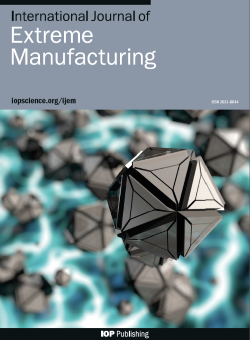光热超疏水铜纳米线组件:制造和除冰/除霜应用
IF 16.1
1区 工程技术
Q1 ENGINEERING, MANUFACTURING
引用次数: 0
摘要
冰与霜的持续积累对多个领域构成了重大挑战。作为一种很有前途的除冰除霜替代方案,利用地球上丰富的阳光资源来设计促进冰/霜融化的光热涂层近年来引起了人们的广泛关注。然而,以前的设计要么由于有限的导热性而受到局部表面加热的影响,要么由于水/基质的强烈相互作用而导致融水去除率不理想。在此,我们开发了一种简单的方法来制造将光热、热传导和超疏水性结合在一起的表面,以实现有效的除冰和除霜。采用铜纳米线组件,这种表面是通过简单的模板辅助电沉积方法制造的,允许我们通过调整模板尺寸和电沉积时间来调整纳米线组件的几何形状。高度有序的铜纳米线组件促进了有效的阳光吸收和侧向热扩散,导致整体温度快速上升,使冰和霜融化。由于表面优异的拒水性,进一步促进解冻的冰和霜可以自发和迅速地去除。通过这种方式,与其他仅具有超疏水性、光热效应或两者兼而有之的纳米结构表面相比,一体化设计能够大大增强除冰和除霜性能。特别是,除霜效率接近100%,与以往的研究相比达到了最高水平。总的来说,我们的方法展示了一条设计高效人工除冰/除霜表面的有希望的道路。本文章由计算机程序翻译,如有差异,请以英文原文为准。
Photothermal superhydrophobic copper nanowire assemblies: fabrication and deicing/defrosting applications
Ice and frost buildup continuously pose significant challenges to multiple fields. As a promising de-icing/defrosting alternative, designing photothermal coatings that leverage on the abundant sunlight source on the earth to facilitate ice/frost melting has attracted tremendous attention recently. However, previous designs suffered from either localized surface heating owing to the limited thermal conductivity or unsatisfied meltwater removal rate due to strong water/substrate interaction. Herein, we developed a facile approach to fabricate surfaces that combine photothermal, heat-conducting, and superhydrophobic properties into one to achieve efficient de-icing and defrosting. Featuring copper nanowire assemblies, such surfaces were fabricated via the simple template-assisted electrodeposition method, allowing us to tune the nanowire assembly geometry by adjusting the template dimensions and electrodeposition time. The highly ordered copper nanowire assemblies facilitated efficient sunlight absorption and lateral heat spreading, resulting in a fast overall temperature rise to enable the thawing of ice and frost. Further promoted by the excellent water repellency of the surface, the thawed ice and frost could be spontaneously and promptly removed. In this way, the all-in-one design enabled highly enhanced de-icing and defrosting performance compared to other nanostructured surfaces merely with superhydrophobicity, photothermal effect, or the combination of both. In particular, the defrosting efficiency could approach ∼100%, which was the highest compared to previous studies. Overall, our approach demonstrates a promising path toward designing highly effective artificial deicing/defrosting surfaces.
求助全文
通过发布文献求助,成功后即可免费获取论文全文。
去求助
来源期刊

International Journal of Extreme Manufacturing
Engineering-Industrial and Manufacturing Engineering
CiteScore
17.70
自引率
6.10%
发文量
83
审稿时长
12 weeks
期刊介绍:
The International Journal of Extreme Manufacturing (IJEM) focuses on publishing original articles and reviews related to the science and technology of manufacturing functional devices and systems with extreme dimensions and/or extreme functionalities. The journal covers a wide range of topics, from fundamental science to cutting-edge technologies that push the boundaries of currently known theories, methods, scales, environments, and performance. Extreme manufacturing encompasses various aspects such as manufacturing with extremely high energy density, ultrahigh precision, extremely small spatial and temporal scales, extremely intensive fields, and giant systems with extreme complexity and several factors. It encompasses multiple disciplines, including machinery, materials, optics, physics, chemistry, mechanics, and mathematics. The journal is interested in theories, processes, metrology, characterization, equipment, conditions, and system integration in extreme manufacturing. Additionally, it covers materials, structures, and devices with extreme functionalities.
 求助内容:
求助内容: 应助结果提醒方式:
应助结果提醒方式:


